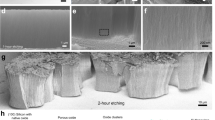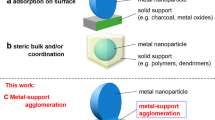Abstract
Metallic contamination was key to the discovery of semiconductor nanowires1, but today it stands in the way of their adoption by the semiconductor industry. This is because many of the metallic catalysts required for nanowire growth are not compatible with standard CMOS (complementary metal oxide semiconductor) fabrication processes. Nanowire synthesis with those metals that are CMOS compatible, such as aluminium2 and copper3,4,5, necessitate temperatures higher than 450 °C, which is the maximum temperature allowed in CMOS processing. Here, we demonstrate that the synthesis temperature of silicon nanowires using copper-based catalysts is limited by catalyst preparation. We show that the appropriate catalyst can be produced by chemical means at temperatures as low as 400 °C. This is achieved by oxidizing the catalyst precursor, contradicting the accepted wisdom that oxygen prevents metal-catalysed nanowire growth. By simultaneously solving material compatibility and temperature issues, this catalyst synthesis could represent an important step towards real-world applications of semiconductor nanowires6,7,8,9,10,11.
This is a preview of subscription content, access via your institution
Access options
Subscribe to this journal
Receive 12 print issues and online access
$259.00 per year
only $21.58 per issue
Buy this article
- Purchase on Springer Link
- Instant access to full article PDF
Prices may be subject to local taxes which are calculated during checkout



Similar content being viewed by others
References
Wagner, R. S. & Ellis, W. C. Vapor–liquid–solid mechanism of single crystal growth. Appl. Phys. Lett. 4, 89–90 (1964).
Wang, Y., Schmidt, V., Senz, S. & Goesele, U. Epitaxial growth of silicon nanowires using an aluminium catalyst. Nature Nanotech. 1, 186–189 (2006).
Yao, Y. & Fan, S. Si nanowires synthesized with Cu catalyst. Mater. Lett. 61, 177–181 (2007).
Arbiol, J., Kalache, B., Cabarrocas, P. R. I., Morante, J. R. & Morral, A. F. I. Influence of Cu as a catalyst on the properties of silicon nanowires synthesized by the vapour–solid–solid mechanism. Nanotechnology 18, 305606 (2007).
Kalache, B., Cabarrocas, P. R. & Morral, A. F. Observation of incubation times in the nucleation of silicon nanowires obtained by the vapor–liquid–solid method. Jpn J. Appl. Phys. 45, L190 (2006).
Lu, W. & Lieber, C. Nanoelectronics from the bottom up. Nature Mater. 6, 841–850 (2007).
Patolsky, F., Timko, B. P., Zheng, G. & Lieber, C. M. Nanowire-based nanoelectronic devices in the life sciences. MRS Bull. 32, 142–149 (2007).
Law, M., Greene, L. E., Johnson, J. C., Saykally, R. & Yang, P. D. Nanowire dye-sensitized solar cells. Nature Mater. 4, 455–459 (2005).
Wang, Z. L. & Song, J. H. Piezoelectric nanogenerators based on zinc oxide nanowire arrays. Science 312, 242–246 (2006).
Chan, C. K. et al. High-performance lithium battery anodes using silicon nanowires. Nature Nanotech. 3, 31–35 (2007).
Duan, X., Huang, Y., Agarwal, R. & Lieber, C. M. Single-nanowire electrically driven lasers. Nature 421, 241–245 (2003).
Kamins, T. I., Stanley Williams, R., Basile, D. P., Hesjedal, T. & Harris, J. S. Ti-catalyzed Si nanowires by chemical vapor deposition: microscopy and growth mechanisms. J. Appl. Phys. 89, 1008–1016 (2001).
Lensch-Falk, J. L., Hemesath, E. R., Perea, D. E. & Lauhon, L. J. Alternative catalysts for VSS growth of silicon and germanium nanowires. J. Mater. Chem. 19, 849–857 (2009).
Wang, N., Tang, Y. H., Zhang, Y. F., Lee, C. S. & Lee, S. T. Nucleation and growth of Si nanowires from silicon oxide. Phys. Rev. B 58, R16024–R16026 (1998).
Morral, A. F., Arbiol, J., Prades, J. D., Cirera, A. & Morante, J. R. Synthesis of silicon nanowires with wurtzite crystalline structure by using standard chemical vapor deposition. Adv. Mater. 19, 1347–1351 (2007).
Prades, J. D., Arbiol, J., Cirera, A., Morante, J. R. & Morral, A. F. Concerning the 506 cm−1 band in the Raman spectrum of silicon nanowires. Appl. Phys. Lett. 91, 123107 (2007).
Wentorf, R. H. & Kasper, J. S. Two new forms of silicon. Science 139, 338–339 (1963).
Yeh, C. Y., Lu, Z. W., Froyen, S. & Zunger, A. Zinc-blende–wurtzite polytypism in semiconductors. Phys. Rev. B 46, 10086–10097 (1992).
Bell, D. C. et al. Imaging and analysis of nanowires. Microsc. Res. Tech. 64, 373–389 (2004).
Zhao, X. S., Ge, Y. R., Schroeder, J. & Persans, P. D. Carrier-induced strain effect in Si and GaAs nanocrystals. Appl. Phys. Lett. 65, 2033–2035 (2004).
Cabrera, N. & Mott, N. F. Theory of the oxidation of metals. Rep. Prog. Phys. 12, 163–184 (1948).
Gong, Y. S., Chiapyng Lee & Yang, C. K. Atomic force microscopy and Raman spectroscopy studies on the oxidation of Cu thin films. J. Appl. Phys. 77, 5422–5425 (1995).
Lampimäki, M., Lahtonen, K., Hirsimäki, M. & Valden, M. Nanoscale oxidation of Cu (100): oxide morphology and surface reactivity. J. Chem. Phys. 126, 034703 (2007).
Jiang, X. C., Herricks, T. & Xia, Y. N. CuO nanowires can be synthesized by heating copper substrates in air. Nano. Lett. 2, 1333–1338 (2002).
Delogu, F. Structural and energetic properties of unsupported Cu nanoparticles from room temperature to the melting point: molecular dynamics simulations. Phys. Rev. B 72, 205418 (2005).
Chromik, R. R., Neils, W. K. & Cotts E. J. Thermodynamic and kinetic study of solid state reactions in the Cu–Si system. J. Appl. Phys. 86, 4273–4281 (1999).
Harper, J. N. E., Charai, A., Stolt, L., d'Heurle, F. M. & Fryer. P. M. Room-temperature oxidation of silicon catalysed by Cu3Si. Appl. Phys. Lett. 56, 2519–2521 (1990).
Baklanov, M. R. et al. Characterization of Cu surface cleaning by hydrogen plasma. J. Vac. Sci. Technol. B 19, 1201–1211 (2001).
Acknowledgements
This work was supported by the French National Research Agency (ANR) through Carnot Funding. We thank D. Lafond and B. Florin for assistance during electron microscopy measurements. We thank C. Charrier and her team for clean room technical assistance. We thank K. Haxaire for diffusion-barrier and metal deposition.
Author information
Authors and Affiliations
Contributions
V.R. and V.J. designed the experiments. V.R. synthesized the nanowires and performed SEM observations. M.J. performed TEM measurements, P.C. tomography experiments, D.R. Raman measurements and P.G. XRD measurements. All the authors analysed the data. V.R. and M.J. co-wrote the paper.
Corresponding author
Supplementary information
Supplementary information
Supplementary information (PDF 661 kb)
Supplementary information
Supplementary information (WMV 3989 kb)
Rights and permissions
About this article
Cite this article
Renard, V., Jublot, M., Gergaud, P. et al. Catalyst preparation for CMOS-compatible silicon nanowire synthesis. Nature Nanotech 4, 654–657 (2009). https://doi.org/10.1038/nnano.2009.234
Received:
Accepted:
Published:
Issue Date:
DOI: https://doi.org/10.1038/nnano.2009.234
This article is cited by
-
Insight of surface treatments for CMOS compatibility of InAs nanowires
Nano Research (2019)
-
Amorphous Silicon Nanowires Grown on Silicon Oxide Film by Annealing
Nanoscale Research Letters (2017)
-
Wafer-level site-controlled growth of silicon nanowires by Cu pattern dewetting
Nano Research (2015)
-
Continuous-flow Mass Production of Silicon Nanowires via Substrate-Enhanced Metal-Catalyzed Electroless Etching of Silicon with Dissolved Oxygen as an Oxidant
Scientific Reports (2014)



